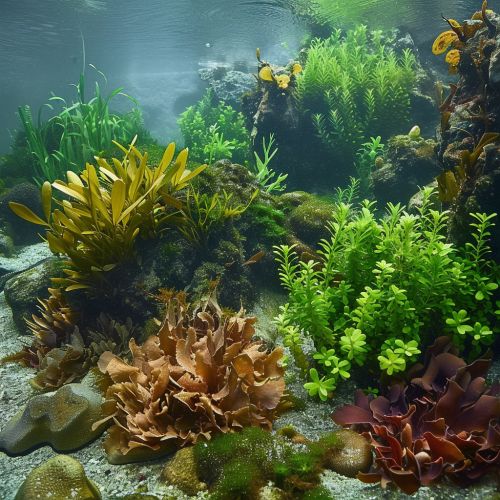Marine Algae
Introduction
Marine algae, also known as seaweeds, are a diverse group of photosynthetic organisms that inhabit the world's oceans. They play a crucial role in marine ecosystems, providing food and shelter for a variety of marine species, and contributing to the global carbon cycle. Marine algae are classified into three main groups: the green algae, red algae, and brown algae, each with distinct characteristics and ecological roles.


Classification and Diversity
Marine algae are highly diverse, with estimates of species numbers ranging from 30,000 to over 1 million. This diversity is reflected in their wide range of sizes, shapes, and colors, as well as their varied ecological roles.
Green Algae
The green algae, or Chlorophyta, are a large group of algae that are predominantly found in freshwater environments, but some species also inhabit marine environments. They are characterized by their green color, which is due to the presence of chlorophyll-a and -b in their chloroplasts. Green algae can be unicellular, multicellular, or form colonies.
Red Algae
Red algae, or Rhodophyta, are predominantly marine algae and are known for their distinctive red color, which is a result of the pigment phycoerythrin. They are an important part of coral reef ecosystems, with some species contributing to the formation of coral reefs through a process known as coral reef formation.
Brown Algae
Brown algae, or Phaeophyceae, are exclusively marine and include some of the largest and most complex algae. They are characterized by their brown or olive-green color, which is due to the presence of the pigment fucoxanthin. Brown algae include the giant kelps, which can form extensive underwater forests.
Ecology
Marine algae play a vital role in marine ecosystems. They are primary producers, converting sunlight into organic matter through photosynthesis. This organic matter forms the base of the marine food web, supporting a wide range of marine species, from tiny zooplankton to large marine mammals.
Marine algae also contribute to the global carbon cycle. Through photosynthesis, they absorb carbon dioxide from the atmosphere and convert it into organic carbon. Some of this carbon is then transferred to the deep ocean when algae die and sink, a process known as the biological pump.
In addition to their ecological roles, marine algae also have significant economic value. They are harvested for use in a variety of products, including food, fertilizers, and pharmaceuticals.
Threats and Conservation
Marine algae face a variety of threats, including pollution, climate change, and overharvesting. These threats can lead to declines in algae populations, with potential impacts on the marine species that depend on them for food and habitat.
Conservation efforts for marine algae include the establishment of marine protected areas, the implementation of sustainable harvesting practices, and research into the impacts of climate change on algae populations.
